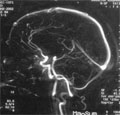The eLitMed.hu medical portal uses computer cookies for convenient operation. Detailed information can be found in the Cookie-policy.
Clinical Neuroscience - 2003;56(11-12)
Content
[Assessment of motor impairment with electromyography - the kinesiological EMG]
[Kinesiological electromyography means the application of the surface EMG measurement technique during movement and locomotion. The authors investigated the motor impairments of the upper limb of patients with spastic hemiparesis. Surface EMG activity in musculus biceps brachii and musculus triceps brachii were recorded during voluntary elbow flexion and extension movements. In some cases even the raw EMG signals contain the accurate information but more often the recorded signals should further be processed to achieve more valuable data concerning muscle performance. The limitations of the technique underlines the importance of the several steps of the processing. The purpose of this study is to present a systematic description of the methods and the precise application of surface EMG. The authors give a comprehensive view of different processing methods and demonstrate the application areas of the kinesiological EMG.]
[Physical and electrophysiological aspects of electroconvulsive therapy (review)]
[Personnel and technical conditions for ECT (electroconvulsive therapy) is legally determined. In this article the author reviews studies focused on the technical questions of ECT. After the comparison of the unilateral and bilateral electrode placement an analysis is given on the physical properties of the stimulus used to elicit seizures. After discussing the questions of dose, vaweform frequency and polarity, the anatomical and physiological factors of impedance are evaluated. The author then discuss gender, age and encephalopathy as factors influencing seizure threshold. The connection between symmetry, regularity, and postictal suppression registered on the EEG and efficacy is observed. The EEG and EMG concordance is supposed to be connected also with the efficacy. In the discussion the author gives recommendations based on the literature.]
[Serotonin dysfunctions and the „Seven Deadly Sins”]
[The symbolic characters of the Seven Deadly Sins can be traced from time to time in the cultural history of human mankind, being directly specified in certain artistic products. Such are, among others, the painting entitled „The Seven Deadly Sins and the Four Last Things” by Hieronymus Bosch and the poems Divina Commedia and The Faerie Queene by Dante Alighieri and Edmund Spenser, respectively. However, there are several paragraphs referring to these behaviours of the Seven Deadly Sins in the Bible and in the dramas of William Shakespeare. The objective of the present review is to propose that dysfunctions in the central serotonergic system might be involved in the the neurobiology of these ’sinful’ behaviour patterns. Evidences indicate that behaviour traits such as Accidia (Sloth), Luxuria (Lust, Lechery), Superbia (Pride), Ira (Wrath, Anger), Invidia (Envy), Avaritia (Greed, Avarice), and Gula (Gluttony) can relate to the functional alterations of serotonin in the brain. Results of biochemical and molecular genetic (polymorphism) studies on the human serotonergic system (receptor, transporter, enzyme), findings of functional imaging techniques, effects of depletion (or supplementation) of the serotonin precursor tryptophan, data of challenge probe investigations directed to testing central serotonergic functions, alterations in the peripheral serotonin measures (platelet), and the changes in the CSF 5-hydroxy-indoleacetic acid content indicate such serotonergic involvement. Furthermore, results of animal experiments on behaviour change (aggressive, dominant or submissive, appetite, alcohol preference) attributed to serotonin status modification and the clinically evidenced therapeutic efficacy of pharmacological interventions, based on the modulation and perturbation of the serotonergic system (e.g. selective serotonin reuptake inhibitors), in treating the ’sinful’ behaviour forms and analogous pathological states reaching the severity of psychiatric disorders (depression, sexual disturbances, social phobia, impulsivity-aggression, obsessive-compulsive and related spectrum disorders, paranoid jealousy, eating disorders) all strongly suggest the possibility that brain serotonin dysfunctions might underlie the neurophysiology of the Seven Deadly Sins.]
[Predictors of lethal outcome in subdural haemorrhage]
[Background - Subdural haemorrhage (SDH) is of high public health importance because of its frequency, high case fatality ratio (CFR) and the young age of affected population. Despite the fact that the effectivity of guideline based treatment has been improved in the last decade, the Hungarian praxis shows variable compliance for recommendations. Objectives - The study aimed to describe the heterogeneity of the treatment effectivity (by geographically identifying the populations provided with appropriate or non-optimal level care), to determine the relationship between the institutional praxis quality and the results of treatment for SDH by linking the praxis properties to the patients' records. Methods - The institutions’ protocols were assessed by a self-completed questionnaire in 1997. The participating hospitals treated 79% of the Hungarian patients with SDH. The Hungarian hospital discharge data in 1997-1999 were the source of patient specific data. The risk factors of lethal outcome were investigated by logistic regression analysis. Results - High proportion of patients had been treated in hospitals with low compliance for guidelines. The non-permanent access to neurosurgical service and CT facility, the lack of intracranial pressure monitoring and the respiration support provided out of intensive care units worsened the survival of subjects. It was quantified that the full compliance could have diminished the case fatality ratio by 15-20%. The ratio of extreme county level CFRs exceeded 2.36 and extrapolating the effectivity observed in the county with lowest lethality, the Hungarian CFR would have been reduced by 21% among patients with SDH main diagnosis. (The interpretation of findings is limited by the lack of differentiation between acute and chronic cases and of direct categorisation of severity for subdural haemorrhage in the official hospital discharge records.) Discussion - The study results urge the increase of compliance for evidence based guidelines, since despite of some validity issues, it was demonstrated that the deviation from recommended practice is reflected in the disadvantageous outcome.]
[HIV infection and neurology - long term follow-up of HIV infected children]
[Objectives - Before the widespread introduction of combined antiretroviral therapy (1995) complications from HIV and AIDS in the central nervous system had been reported in larger proportion in infants and children than in adults: 80-90% versus 60-70%. Particular clinical manifestations tend to occur at different stages during the evolution of HIV infection. The authors review the neurological aspects of HIV infection. Method - First, a summary of the protocol of the neurological examinations and related experience is given. Then authors present the evaluation of neuro-psychological development, prevalence of neurological impairment and neuro-imaging of nine HIV infected children (seven boys, two girls) for the period of ten years (1991-2001). Three/ten children had vertically transmitted HIV, six/nine were infected by a nosocomial route in their early childhood. Children were regularly followed up from the diagnosis of HIV. The median follow up time has been 79 month (range: 18-144 month). Four patients died during the study period. The neurological status, the motor and mental development were examined at three month intervals or monthly under one year of age. EEG was performed every six month and CT/MRI once a year. All patients received combined antiretroviral treatment and immunglobulin therapy continuously. Results - Three/nine children have normal development, one/nine has hyperactive and attention deficit disorder with normal IQ range, two/nine have slight, one/nine moderate and two/nine serious mental retardation. Mild neurological signs were found in two children, various moderate and serious neuro/psychological symptoms were found in four patients, one of them was treated with benign epilepsy too. There was also close correlation between the clinical symptoms and the results of EEG examination (diffuse background slowing) and results of neuroimaging studies (cortical atrophy, calcification of the basal ganglia, toxoplasma abscesses). According to the results of different examinations three/nine children were found to be symptom-free, one/nine case showed the static form, two/nine patients showed the plateau form, two/nine the rapid progressive form and one/nine the progressive infantile form of AIDS encephalopathy. The majority of the patients suffered from adapting problems and difficulties of socialisation since their families lives were damaged by isolation and rejection from the community. Conclusion - The regular neurological and psychological examinations completed with EEG, CT/MRI were very informative to follow the course of neuro-psychological problems of HIV infected children. Symptom-free patients have to face psychosocial problems too, which cause much more damage in their mental progress than HIV itself.]
[Thallium poisoning induced polyneuropathy - clinical and electrophysiological data]
[Introduction - The aim of the study was the electrophysiological investigation of thallium induced polyneuropathy. Beyond the rarity of the illness, the motivation of this work was the possibility of following up the pattern of neuronal damage. Thallium is one of the most toxic heavy metal and its wide use increases the chance of chronic or accidental acute poisoning. The entero-hepatic circulation makes the accumulation of this toxic agent in tissues possible, mostly in neurons, in the epithelial cells of the digestive tract, in the germinative cells of the skin and testicles. In addition to alopecia and digestive complaints, the clinical picture of thallium poisoning is dominated by neurological signs. Severe axonal polyneuropathy develops in almost all cases, with further damage to the retina and impairment of cognitive functions being not unusual. The diagnosis is confirmed by finding high levels of thallium in body fluids, especially in saliva and urine. Case report - Electrophysiological examination of our accidentally poisoned patient revealed severe, sensory-motor, predominant motor axonal polyneuropathy and pointed out some aspects of the pattern of neurotoxic process: the initially distal lesion, the dying-back course and the capacity for regeneration. Conclusion - Because thallium has the same molecular targets as potassium ion thus impairing the energetical supply of the nerve cell, the most effective treatment is carefully loading with potassium. If recognized and treated early, thallium poisoning has a favourable prognosis.]
[Occipital sinus in patients suspect for dural sinus thrombosis - Case report]
[Introductions - The diagnosis of dural sinus thrombosis despite of using modern imaging techniques still remains a difficult problem. For satisfactory interpretation of CT and MR scans it is indispensably important the knowledge of anatomical variations and possible imaging artifacts. One of the relatively rare developmental variations - giving chance for making false positive diagnosis - is the occipital sinus with hypoplasia or agenesis of transverse sinus. Case reports, Conclusion - The incidence, the anatomical classification, the importance and the possibility of differentiation from sinus thrombosis are reviewed based on case reports of four patients.]
[The role of studies of Janos Szentagothai in developmental neurology]
[The vestibulospinal system plays determining role in the activation processes of elementary sensorymotor patterns characterised by the verticalisation of the trunk and elevation of the head. In the thirties of the last century János Szentágothai proved that axons of the vestibulospinal tract reach the cervical and thoracic spinal cord and innervate the muscles of the neck. Later he verified existence of various connections among the labyrinth, the vestibular system, and the motor nuclei of the III., IV. and the VI. cranial nerves. His studies explain the functional neuroanatomic background of sitting up, sitting and balancing in the air, head-elevation and head control during the execution of a special elementary sensorymotor pattern: ”sitting in air”. All these functions can be activated by labyrinthine stimulation long before the maturation of the corticospinal tract.]
1.
Clinical Neuroscience
[Headache registry in Szeged: Experiences regarding to migraine patients]2.
Clinical Neuroscience
[The new target population of stroke awareness campaign: Kindergarten students ]3.
Clinical Neuroscience
Is there any difference in mortality rates of atrial fibrillation detected before or after ischemic stroke?4.
Clinical Neuroscience
Factors influencing the level of stigma in Parkinson’s disease in western Turkey5.
Clinical Neuroscience
[The effects of demographic and clinical factors on the severity of poststroke aphasia]1.
2.
3.
4.
5.










